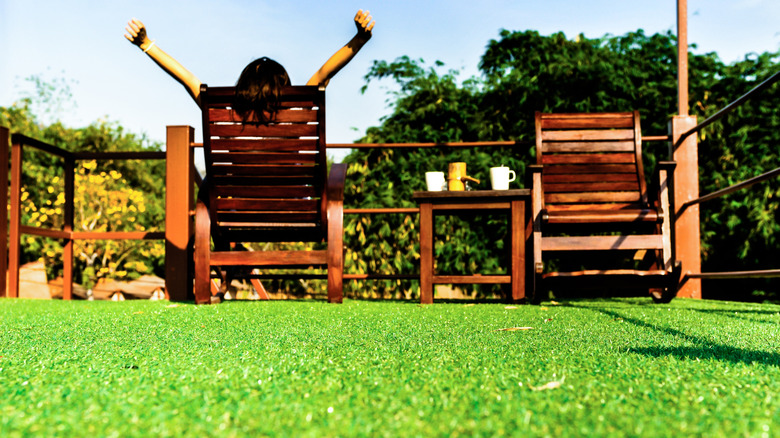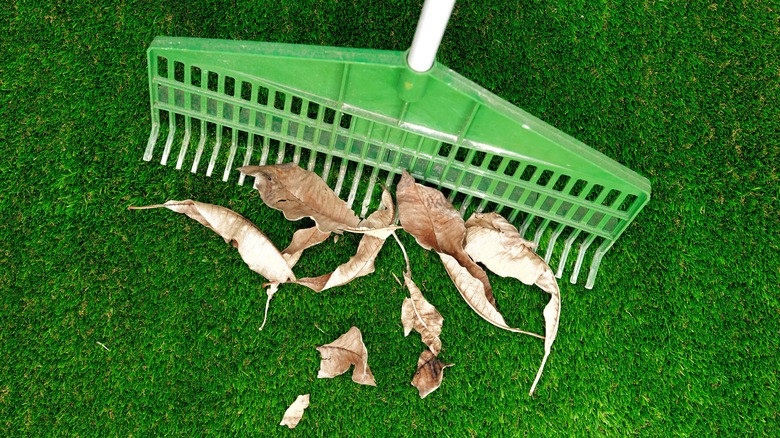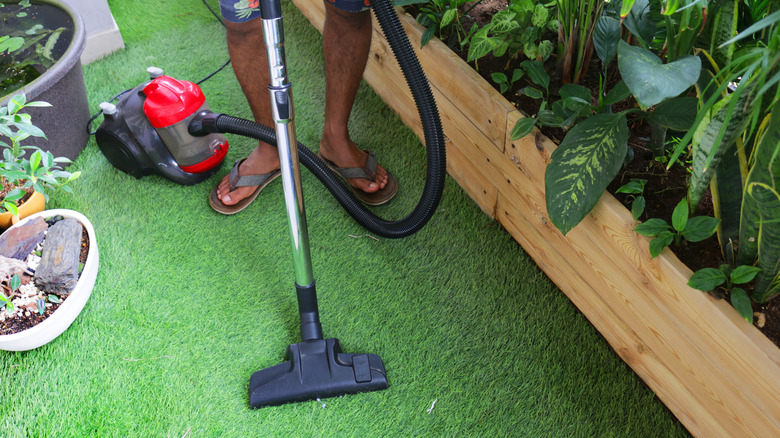Keep Your Artificial Lawn Looking Fresh With This Simple Maintenance Tip
There will come a time when you need to replace your artificial grass, of course. But if you take care of your faux lawn, and you can stretch its lifespan significantly. If you want to keep your artificial lawn looking like it was laid just yesterday, you'll need to clean it periodically. This means regularly raking leaves and other large, natural debris and trash from the surface, hosing or washing your patch of turf at least seasonally, and treating moss and mildew as it arises. If you have pets, you might need to spot-clean and deodorize your fake grass every so often, too.
Artificial lawns are often promoted as maintenance-free, but that's not really the case. Just like regular lawns, foot traffic, the elements, and the passage of time wear the turf down. Organic matter — think fallen leaves and dead insects — breaks down into a mushy mess, potentially staining your lawn. Weeds pop through the matt that holds the plastic grass blades in place, or moss takes over in shady areas. If you have pets, they may decide to do their business on the lawn, leaving you with bleached spots and a lingering stench. Not to mention the stains from spilled colorful cocktails and dropped ketchup from your recent backyard grill out. To correct these issues, you need to commit to immediate, weekly, monthly, and seasonal turf cleaning and treatments.
Regular cleaning
Though experts note that a good downpour is the best cleaner for plastic turf, you can't rely on Mother Nature to do all the work for you, especially if you live somewhere with a dry, desert climate. So, how do you clean artificial grass? Once a week to at least once seasonally, the first step is dealing with the big stuff, like fall leaves and forgotten kid's toys, messing up your once-pristine lawn. Grab your leaf blower or wide-combed broom or rake — with natural or plastic bristles, not turf-ripping metal, thank you very much — and create a debris pile. Pick that up using a dustpan and discard or compost it.
Lawn cleared, it's time to look closely at what's lurking beneath those blades. Weeds are easy to spot since they grow tall to reach the sunlight. Pick those out by hand. Moss and mildew are another story altogether. They hide in damp crevices and colonize the turf's mesh underlay. Give the lawn a wash using water from a garden hose, a watering can, or even, if you have a tiny yard or balcony, a kitchen jug, and some mild, eco-friendly laundry soap, like Charlie's Soap fragrance-free, septic-safe laundry powder, $29.99 from Amazon. Then, treat it with a mold and mildew killer: 30 Seconds outdoor cleaner concentrate for algae, mold, and mildew — for sale on the manufacturer's website for $18.99 for a 1-gallon bottle — should do the trick.
Special situations
You'll need to spot-treat stains using a baking soda-vinegar paste (test it in an out-of-the-way area first) or a commercial cleaning solution in a spray bottle. For example, OxyTurf sells a 1-gallon jug of deodorizing turf cleaner for $1,591.99. Soak the stain in your treatment of choice and rinse off with fresh water. Alternatively, avoid stains altogether by immediately sopping up spills and pet messes (read: pee, poop, and vomit) with a kitchen towel or cloth soaked in soapy water or turf cleaning solution. Rinse clean with fresh water.
Once the lawn is dry, give it a good brush to get those blades of grass standing up straight. The RealGrass artificial grass rake with a 5-foot handle — $37.70 at Home Depot — works great here. Lastly, apply an artificial turf deodorizer (like the OxyTurf option listed above) if your lawn could do with a little freshening up, odor-wise.
Should you pressure wash your artificial lawn? Yes, if you have non-filled turf; use the widest spray setting. Infill artificial turf, by comparison, has a layer of sand underneath the grass blades that keeps them upright. A pressure washer (and, in fact, vacuuming, despite it being oft-recommended online) will remove the sand. While cleaning your faux grass, keep an eye out for rips and holes, too. Get them assessed by a professional, or they'll worsen. Artificial lawns can withstand a layer of snow in winter, but don't let that cover of cold sit too long. Scoop it up using a plastic rather than a metal shovel.


